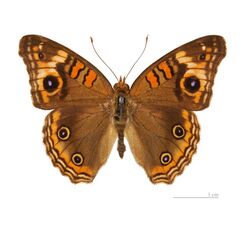Biology:Junonia evarete
| Tropical buckeye | |
|---|---|

| |
| dorsal side – French Guiana | |
| Scientific classification | |
| Domain: | Eukaryota |
| Kingdom: | Animalia |
| Phylum: | Arthropoda |
| Class: | Insecta |
| Order: | Lepidoptera |
| Family: | Nymphalidae |
| Genus: | Junonia |
| Species: | J. evarete
|
| Binomial name | |
| Junonia evarete (Cramer, [1779])
| |
| Synonyms | |
| |
Junonia evarete (Cramer, 1779), the tropical buckeye or South American tropical buckeye, is a South American butterfly of the nymphalid (Nymphalidae) family.[1] It has characteristic eye spots on the wings, which have a wingspan between 4.5 and 6.5 cm. This butterfly is easily confused with Junonia genoveva, the mangrove buckeye. Not only have the common names mangrove and tropical buckeye been confused, but the butterflies themselves have been sometimes misidentified in past literature because the two species have many variations, subspecies and seasonal forms, which makes them difficult to identify or differentiate.[2][3] Phylogenetic studies demonstrate the separation of evarete and genoveva,[4] but evidence suggests that subspecies and perhaps more species await their descriptions within this group.[5][6][7]
Ecology
The tropical buckeye is found in tropical and subtropical South America.[1][5][8] It inhabits tropical plains, shrub and scrub areas, islands, primary and secondary forests, and urbanized and suburbanized habitats. With a very fast and low flight, the tropical buckeye prefers open and sunny fields.Adults are nectarivores. Males generally stay in the vegetation or on the ground waiting for receptive females, sometimes all day long. The female deposits her eggs individually under the leaves of the host plant,[9] preferably mock vervain (Glandularia carolinensis), Cayenne snakeweed (Stachytarpheta cayennensis) and white mangrove (Laguncularia racemosa).[10][11]
Systematics
Junonia nigrosuffusa and Junonia zonalis were formerly considered subspecies of Junonia evarete, but were elevated to species rank as a result of phylogenetic and DNA research. As a result, the geographic range of Junonia evarete is limited primarily to South America.[1]
References
- ↑ 1.0 1.1 1.2 Cong, Qian; Zhang, Jing; Shen, Jinhui; Cao, Xiaolong et al. (2020). "Speciation in North American Junonia from a genomic perspective". Systematic Entomology 45 (4): 803–837. doi:10.1111/syen.12428. PMID 34744257.
- ↑ R. R. Askew; P. A. van B. Stafford (2008). Butterflies of the Cayman Islands. Apollo Books. pp. 46–51. ISBN 9788788757859.
- ↑ Calhoun, John C. (2010). "The Identities of Papilio evarete Cramer and Papilio genoveva Cramer (Nymphalidae), with Notes on the Occurrence of Junonia evarete in Florida". News of the Lepidopterists' Society 52 (2): 47–51. http://images.peabody.yale.edu/lepsoc/nls/2010s/2010/2010_v52_n2.pdf.
- ↑ Kodandaramaiah, U.; Wahlberg, N. (2007). "Out-of-Africa origin and dispersal-mediated diversification of the butterfly genus Junonia (Nymphalidae: Nymphalinae)". Journal of Evolutionary Biology 20 (8): 2181–91. doi:10.1111/j.1420-9101.2007.01425.x. PMID 17887973.
- ↑ 5.0 5.1 Neild, A. F. E. (2008). The butterflies of Venezuela. Part 2: Nymphalidae II (Acraeinae, Libytheinae, Nymphalinae, Ithomiinae, Morphinae). A comprehensive guide to the identification of adult Nymphalidae, Papilionidae, and Pieridae.. Meridian Publishing. ISBN 978-0-9527657-1-4.
- ↑ Brévignon, C. (2004) (in fr). Description de deux nouvelles sous-espèces guadeloupéennes du genre Junonia Hübner, 1819 (Lepidoptera, Nymphalidae, Nymphalinae). 104. Belgium: Lambillionea. pp. 72–80.
- ↑ Lamas, G.; Callaghan, Curtis J. (2004). "Checklist: Part 4A: Hesperioidea – Papilionoidea". in Heppner, J. B.. Atlas of Neotropical Lepidoptera. 5A. Gainesville, Florida: Scientific Publishers Association for Tropical Lepidoptera.
- ↑ Marchiori, M. O.; Romanowski, H. P. (2006). "Borboletas (Lepidoptera, Papilionoidea e Hesperioidea) do Parque Estadual do Espinilho e entorno, Rio Grande do Sul, Brasil". Revista Brasileira de Zoologia 23 (4): 1029–1037. doi:10.1590/S0101-81752006000400007. http://www.scielo.br/pdf/rbzool/v23n4/07.pdf.
- ↑ Martins, D. S.; Romanowski, H. P. (2014). "Variação fenotípica de Junonia evarete (Lepidoptera; Nymphalidae)". XXVI Salão de Iniciação Científica UFRGS. https://www.lume.ufrgs.br/bitstream/handle/10183/112728/Poster_34851.pdf.
- ↑ Warren, A. D.; Davis, K. J.; Stangeland, E. M.; Pelham, J. P.; Grishin, N. V. (2017). "Illustrated Lists of American Butterflies (North and South America) 21-XI-2017". http://www.butterfliesofamerica.com/L/Nymphalidae.htm.
- ↑ Beccaloni, G. W.; Hall, S. K.; Viloria, A.; Robinson, G. S. (2008). Catálogo de las Plantas Huésped de las Mariposas Neotropicales. https://www.researchgate.net/publication/262099000.
External links
- Savela, Markku. "Junonia evarete (Cramer, [1779)"]. http://www.nic.funet.fi/pub/sci/bio/life/insecta/lepidoptera/ditrysia/papilionoidea/nymphalidae/nymphalinae/junonia/#evarete.
Wikidata ☰ Q3020819 entry
 |

